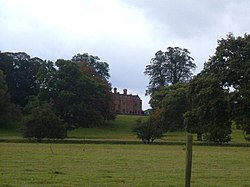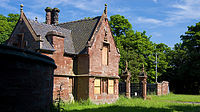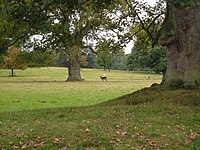Aqualate Hall: Difference between revisions
Created page with "{{Infobox house |name=Aqualate Hall |county=Staffordshire |picture=Aqualate Hall - geograph.org.uk - 566469.jpg |picture caption=Aqualate Hall |latitude=52.7745 |longitude=-2...." |
|||
| Line 25: | Line 25: | ||
==Name== | ==Name== | ||
The name Aqualate is much older than the house. It appears to be from the Old English ''Ac-gelad'', or ' | The name Aqualate is much older than the house. It appears to be from the Old English ''Ac-gelad'', or 'oak-lode', probably in the sense "difficult passage over wet ground by the oak trees"; there is much wet and boggy ground in the area and the lake. | ||
==See also== | ==See also== | ||
Latest revision as of 12:44, 25 June 2015
| Aqualate Hall | |
| Staffordshire | |
|---|---|
 Aqualate Hall | |
| Location | |
| Location: | 52°46’28"N, 2°20’11"W |
| History | |
| Country house | |
| Information | |
Aqualate Hall a 20th-century country house in Staffordshire, nestled up to the county's border with Shropshire, its estate encompassing a fine lake, Aqualate Mere. The house is 3½ miles east of Newport in the latter county, while ten miles west of Stafford. The house is a Grade II* listed building[1]

The first manor house on the site, built above the mere in the 16th century by Thomas Skrymsher [1] was rebuilt for Edwin Skrymsher (Member of Parliament for Stafford) in the 17th century [1] just after he had completed nearby Forton Hall. The original building remained in much the same style until, Sir John Boughey bought the house in the late 18th century and in 1808 commissioned John Nash to rebuild it in the Gothic style.
The building was destroyed by fire on 28 November 1910.
The present house, which incorporates some elements of the 17th-century house and of Nash's Gothic successor, was built between 1927 and 1930 by W D Caroe. An original range of gables by Nash joins the new house to an 18th-century stable block.

The hall has a landscaped deer park with many old trees and stands alongside Aqualate Mere.[2]
In the grounds can be found two Gothic lodge-houses, and a red brick house with an attached castellated tower.
Name
The name Aqualate is much older than the house. It appears to be from the Old English Ac-gelad, or 'oak-lode', probably in the sense "difficult passage over wet ground by the oak trees"; there is much wet and boggy ground in the area and the lake.